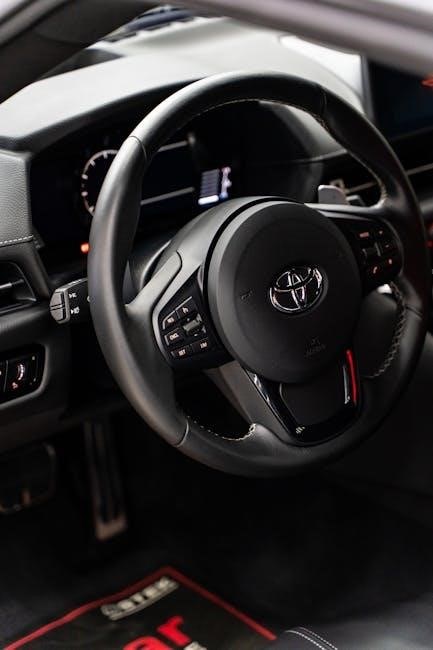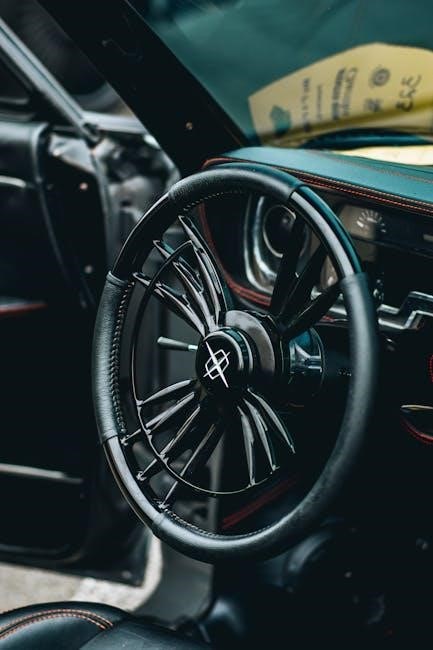Manual and automatic transmissions are two primary gearbox types in vehicles, each offering unique benefits. This guide explores their differences, pros, cons, and uses to help you decide.
Overview of Transmission Types
Manual and automatic transmissions are the two main types of gearboxes in vehicles. Manual transmissions require the driver to manually shift gears using a clutch pedal and gearshift, offering more control. Automatic transmissions automatically change gears without driver input, providing convenience. Both systems have distinct mechanisms, benefits, and drawbacks, catering to different driving preferences and conditions. Understanding their operation and differences helps drivers choose the best option for their needs, lifestyle, and budget.
Importance of Understanding the Differences
Understanding the differences between manual and automatic transmissions is crucial for making informed decisions when purchasing or driving a vehicle. Each type offers unique advantages, such as cost, fuel efficiency, and driving experience. Knowing these distinctions helps drivers choose the best transmission for their lifestyle, whether prioritizing control and engagement or convenience and ease. This knowledge also aids in maintenance and repair decisions, ensuring optimal performance and longevity of the vehicle.

What is a Manual Transmission?
A manual transmission requires the driver to engage the clutch and shift gears manually, offering greater control and driving engagement compared to automatic transmissions.
Definition and Mechanism
A manual transmission, also known as a stick shift, is a type of gearbox that requires the driver to manually change gears using a clutch pedal and gearshift. The mechanism involves pressing the clutch to disengage the engine from the transmission, allowing the driver to shift gears. This system provides direct control over gear selection, enabling precise acceleration and deceleration. Unlike automatic transmissions, manual transmissions rely on driver input to operate, making them more engaging and often preferred for performance driving.
Key Components of a Manual Transmission
A manual transmission consists of several essential components. The clutch pedal disengages the engine from the transmission, allowing gear shifts. The gearshift selects the desired gear, while the transmission housing contains the gears and bearings. The flywheel connects to the engine, and the pressure plate holds the clutch disc in place. These components work together to enable manual gear changes, providing drivers with direct control over the vehicle’s speed and torque.
How Manual Transmissions Work
A manual transmission operates by disconnecting the engine from the wheels using the clutch pedal. When the driver presses the clutch, they can shift gears using the gearshift. Releasing the clutch slowly while pressing the accelerator engages the selected gear, transferring power back to the wheels. This process requires driver input to manually select the appropriate gear for speed and torque, providing precise control over the vehicle’s performance and acceleration.

What is an Automatic Transmission?
An automatic transmission shifts gears automatically without driver input, using a torque converter to transfer power. It simplifies driving, especially in heavy traffic, by eliminating manual shifting.
A manual transmission requires the driver to manually change gears using a clutch pedal and gearshift. An automatic transmission, however, automatically shifts gears without driver input, using a torque converter to smoothly transition between gears. This mechanism allows the vehicle to operate without manual intervention, making it easier to drive, especially in stop-and-go traffic. The automatic system uses sensors and hydraulic controls to determine the optimal gear for driving conditions, providing a more convenient and hands-free driving experience compared to manual transmissions.
Key Components of an Automatic Transmission
An automatic transmission consists of a torque converter, planetary gear set, hydraulic system, sensors, and a transmission control module. The torque converter replaces the clutch, connecting and disconnecting the engine from the transmission. The planetary gear set provides multiple gear ratios for smooth acceleration. Hydraulic pressure, controlled by sensors and the transmission control module, engages and disengages clutches and bands to shift gears automatically. These components work together to enable seamless gear transitions without driver input, ensuring efficient and comfortable driving experiences in various conditions.
How Automatic Transmissions Work
An automatic transmission operates by using a torque converter to connect the engine to the transmission, eliminating the need for a clutch pedal. As the engine accelerates, sensors monitor speed and throttle position, sending signals to the transmission control module. This module activates hydraulic pressure to engage clutches and bands, shifting gears seamlessly. The planetary gear set provides multiple gear ratios for smooth acceleration. The system automatically adjusts to driving conditions, ensuring optimal performance without driver intervention, making it convenient for everyday driving.

Key Differences Between Manual and Automatic
Manual transmissions require driver engagement with a clutch and gearshift, offering control and fuel efficiency. Automatics prioritize convenience, shifting gears automatically for ease in traffic and city driving.
Gear Shifting and Driver Involvement
Manual transmissions require active driver participation, using a clutch pedal and gearshift to change gears, offering precise control and a more engaging driving experience. Automatic transmissions shift gears automatically, reducing driver effort and complexity, especially in heavy traffic or city driving. Manuals provide better fuel efficiency and driver connection, while automatics prioritize convenience and ease of use, making them ideal for everyday commuting and less stressful driving conditions.
Cost Differences
Manual transmissions are generally less expensive to purchase and maintain compared to automatics. They often have lower upfront costs and simpler mechanics, reducing repair expenses. Automatic transmissions, especially modern ones with advanced features, tend to be pricier due to their complex components. However, the convenience and ease of automatics can justify the higher cost for many drivers, making the choice depend on budget and driving preferences.
Fuel Efficiency
Manual transmissions are often more fuel-efficient than automatics, especially in city driving, due to better control over gear shifts. Automatics, particularly older models, may consume more fuel because of torque converters and fluid friction. However, modern automatics with advanced technologies, like continuously variable transmissions (CVTs), have narrowed the efficiency gap. Ultimately, fuel efficiency depends on driving habits, vehicle type, and transmission technology, making it essential to consider these factors when choosing between manual and automatic transmissions.
Driving Experience and Control
Manual transmissions offer a more engaging driving experience, requiring active participation with the clutch and gearshift, which can enhance control and connection to the vehicle. Automatics provide a smoother, hands-free experience, ideal for stop-and-go traffic. In inclement weather, manuals allow drivers to downshift for better traction, while automatics may lack this precision. The choice between the two often comes down to personal preference and the type of driving conditions one frequently encounters, as each transmission type caters to different needs and driving styles.
Maintenance and Repair
Manual transmissions generally require less maintenance and are cheaper to repair compared to automatics. They have fewer complex components, with the clutch being the most common part needing replacement. Automatic transmissions, however, involve more intricate parts like torque converters and planetary gears, which are costly to repair. While modern automatics have improved in reliability, their maintenance and repair expenses remain higher than manuals. Regular fluid changes are essential for both, but automatics often need more frequent servicing to ensure optimal performance and longevity.
Resale Value
Manual transmissions often retain higher resale value, especially in sports and performance car markets, as they are sought after by driving enthusiasts. Automatics, while more popular, may depreciate slightly faster due to their higher maintenance costs over time. However, in regions where automatics dominate, they may hold value better. Ultimately, resale value depends on regional preferences and the specific vehicle type, with modern automatics in high-demand segments also maintaining strong resale potential.
Insurance Costs
Insurance costs for manual and automatic transmissions are generally similar, though automatics may be slightly more expensive to insure due to their complexity and higher repair costs. However, driving habits and vehicle type often play a larger role in determining premiums. Manuals are sometimes seen as less convenient, potentially affecting rates in certain regions. Overall, the difference in insurance costs is minimal, but automatics might edge out as slightly more expensive due to their advanced components and higher maintenance needs.
Driving Conditions and Suitability
The choice between manual and automatic transmissions often depends on driving conditions and personal preference. Manual transmissions are ideal for hilly or snowy terrain, as they allow drivers to downshift for better control. Automatics, however, excel in heavy traffic or urban areas, where frequent stopping and starting can be less tiring. Regionally, manuals are popular in Europe for sporty driving, while automatics dominate in the U.S. for their convenience in city commutes. Each type suits different lifestyles and environments, making the decision subjective based on usage scenarios.

Pros and Cons of Manual Transmissions
Manual transmissions offer better fuel efficiency and lower costs but require more driver skill and effort. They provide greater control but can be tiring in heavy traffic conditions.
Advantages of Manual Transmissions
Manual transmissions offer better fuel efficiency, lower purchase costs, and greater control over driving. They provide a more engaging experience, allowing drivers to connect deeply with the vehicle. Additionally, manuals are lighter and simpler in design, reducing overall weight and improving performance. They also require less complex technology, making them more reliable in certain conditions. For enthusiasts, manuals deliver a more immersive driving experience, especially in sports or performance vehicles, where precise gear control is advantageous.
Disadvantages of Manual Transmissions
Manual transmissions require more driver engagement, as shifting gears and using the clutch can be tiring in heavy traffic. They also demand a learning curve for new drivers to master smooth shifting. Additionally, manuals may not be as comfortable for city driving or frequent stop-and-go situations. While they often offer better fuel efficiency, modern automatics have narrowed this gap. Manuals also lack the convenience of hands-free gear shifting, making them less appealing for casual or urban drivers seeking ease and comfort.

Pros and Cons of Automatic Transmissions
Automatic transmissions offer ease of use, reduced driver fatigue, and smooth operation in traffic, but may cost more and lack the fuel efficiency of manuals.
Advantages of Automatic Transmissions
Automatic transmissions provide ease of use, reducing driver fatigue in heavy traffic. They offer smooth, seamless gear shifts, making them ideal for urban driving. With no clutch pedal, operation is simpler, especially for new drivers. Automatics also provide better low-speed control, such as in parking lots or steep hills. Additionally, they allow drivers to keep both hands on the wheel, enhancing safety. Overall, automatic transmissions deliver convenience and comfort, making them a popular choice for daily commuting and city driving.
Disadvantages of Automatic Transmissions
Automatic transmissions are generally more expensive to purchase and maintain than manuals. They often consume more fuel, reducing efficiency. With less driver control, automatics can feel less engaging for enthusiasts. In hilly or towing situations, they may struggle to find the right gear. Additionally, automatics can be slower to respond in dynamic driving conditions. While convenient, these drawbacks make them less appealing for performance or economy-focused drivers.

Use Cases for Manual vs. Automatic
Manual transmissions excel in sports and performance cars, offering precise control. Automatics are ideal for daily commuting, providing convenience. Regional preferences also influence transmission choices.
Manual Transmissions in Sports and Performance Cars
Manual transmissions are often preferred in sports and performance cars due to their precise control and driver engagement. They allow for quicker gear shifts and better fuel efficiency, enhancing acceleration and responsiveness. This makes them ideal for drivers seeking an immersive and dynamic driving experience, particularly on racetracks or winding roads where control is crucial. The ability to manually shift gears provides a connection to the vehicle, making manual transmissions a staple in high-performance vehicles.
Automatic Transmissions in Daily Commuting
Automatic transmissions are ideal for daily commuting due to their ease of use and comfort in stop-and-go traffic. They eliminate the need for manual gear shifting, reducing driver fatigue and stress. This makes them perfect for urban environments where frequent stopping and starting are common. Additionally, automatics are more accessible for new drivers, as they require less skill and attention. Their smooth operation enhances the overall commuting experience, making them a popular choice for everyday driving in busy cities.
Regional Preferences for Transmission Types
Regional preferences for manual and automatic transmissions vary significantly. In Europe and Asia, manual transmissions are more common due to their fuel efficiency and lower cost. In contrast, automatics dominate in the U.S., where convenience and ease of use are prioritized. Additionally, in regions with heavy traffic, like parts of Asia, automatics are preferred for their stress-free operation. These preferences are shaped by cultural driving habits, road conditions, and economic factors, influencing transmission choices worldwide.

Maintenance and Repair Differences
Manual transmissions are simpler and more cost-effective to maintain, with less frequent servicing needs. Automatics are more complex, requiring specialized tools and higher repair costs.
Maintenance Requirements for Manual Transmissions
Manual transmissions are relatively simple and require less frequent servicing. The clutch may need replacement every 50,000 to 100,000 miles, depending on driving habits. Gear oil changes are less common, typically every 30,000 to 60,000 miles. Overall, manual transmissions are more cost-effective to maintain compared to automatics, with fewer components and less complexity. Regular inspections of the clutch and gearbox ensure optimal performance and prevent major repairs.
Maintenance Requirements for Automatic Transmissions
Automatic transmissions require more frequent and specialized maintenance. Fluid changes are recommended every 30,000 to 60,000 miles to ensure smooth operation. The transmission filter should be replaced periodically to prevent debris buildup. Additionally, the torque converter and solenoid pack may need attention over time. Regular servicing is crucial to avoid costly repairs, as automatics have more complex components compared to manuals. Proper maintenance ensures longevity and optimal performance of the transmission system.
Cost Comparison of Repairs
Repair costs for automatic transmissions are generally higher due to their complex design. Components like the torque converter and solenoid pack can be expensive to replace. Manual transmissions, with fewer parts, typically incur lower repair costs. However, clutch replacements in manuals can add up over time. On average, automatics are more costly to fix, especially when advanced electronics or hydraulic systems fail. Labor costs also tend to be higher for automatics due to their intricate mechanisms.
Fuel Efficiency Comparison
Manual transmissions often offer better fuel efficiency, especially in city driving, due to driver control over gear shifts. Automatics have improved but may still lag slightly.
Fuel Efficiency in Manual Transmissions
Manual transmissions generally offer better fuel efficiency, especially in city driving, due to the driver’s control over gear shifts. This direct engagement allows for optimal power use, reducing waste. Modern manuals often feature lightweight materials and optimized gear ratios, enhancing mileage; Additionally, the ability to downshift before braking reduces wear on the braking system, further improving efficiency. However, driver behavior plays a significant role, as aggressive driving can negate fuel savings. Overall, manuals tend to outperform automatics in fuel economy, particularly in stop-and-go traffic conditions.
Fuel Efficiency in Automatic Transmissions
Automatic transmissions have improved significantly in fuel efficiency, thanks to advanced technologies like continuously variable transmissions (CVTs) and multi-speed gearboxes. These systems optimize gear ratios for better mileage, especially in highway driving. However, automatics typically consume slightly more fuel than manuals due to the torque converter’s energy loss. Modern automatics with features like lock-up torque converters and adaptive shift controls help minimize this gap, making them more competitive in terms of efficiency, particularly in steady driving conditions where the system can operate optimally.
Modern Advances in Fuel Efficiency
Modern transmissions have seen significant advancements in fuel efficiency. Automatics now feature technologies like adaptive shift controls and CVTs, optimizing performance. Manuals benefit from improved clutch materials and gear ratios. Dual-clutch transmissions blend manual control with automatic efficiency. These innovations reduce fuel consumption, especially in city driving. Both types now offer competitive mileage, narrowing the gap. Modern systems prioritize eco-friendly performance without sacrificing power, making both options viable for fuel-conscious drivers. These advancements ensure better mileage and lower emissions across the board.

Modern Developments in Transmission Technology
Recent advancements include dual-clutch and CVT transmissions, enhancing efficiency and performance. These innovations bridge the gap between manual and automatic, offering smoother, more responsive driving experiences.
Advancements in Manual Transmissions
Modern manual transmissions feature improved gear ratios, lighter materials, and smoother clutch engagement. Dual-clutch systems and automated manuals enhance performance while retaining driver control. These advancements boost fuel efficiency and reduce wear, making manuals more appealing for both daily driving and high-performance applications. Innovations like rev-matching technology simplify shifting, reducing driver fatigue. Such updates ensure manual transmissions remain relevant, blending tradition with cutting-edge engineering for a more engaging and efficient driving experience.
Advancements in Automatic Transmissions
Modern automatic transmissions have evolved significantly, featuring technologies like continuously variable transmissions (CVT) and multi-speed automatics with advanced torque converters. These systems improve fuel efficiency and provide smoother gear shifts. Additionally, the integration of AI and adaptive learning allows automatic transmissions to predict driving patterns and optimize gear changes. Such innovations enhance performance, reduce driver input, and cater to diverse driving conditions, making automatics more versatile and efficient than ever before.
Emergence of Semi-Automatic and Dual-Clutch Transmissions
Semi-automatic and dual-clutch transmissions (DCTs) blend manual and automatic features, offering a hybrid driving experience. Semi-automatics use electronic controls to shift gears without a clutch pedal, while DCTs employ two clutches for faster, smoother transitions. These systems combine the efficiency of manuals with the convenience of automatics, enhancing performance and fuel efficiency. They are particularly popular in sports cars and urban vehicles, providing drivers with adaptable control and seamless gear changes, catering to diverse driving preferences and conditions.
In conclusion, manual and automatic transmissions cater to different driving preferences, with manuals offering engagement and control, while automatics provide convenience and ease, making the choice personal.
Final Thoughts on Manual vs. Automatic
The debate between manual and automatic transmissions often comes down to personal preference and driving habits. Manuals offer a more engaging, cost-effective experience, while automatics provide convenience and ease, especially in heavy traffic. Consider your lifestyle, budget, and typical driving conditions when deciding. Manuals are ideal for enthusiasts seeking control, while automatics suit those prioritizing comfort. Ultimately, both options have evolved to meet modern demands, ensuring a smooth and efficient driving experience regardless of choice.
Recommendations for Choosing the Right Transmission
Choose a manual transmission if you value driver engagement, lower costs, and better fuel efficiency, especially for sporty or hilly driving. Opt for an automatic if convenience, ease in traffic, and smooth acceleration are priorities. Consider your lifestyle, budget, and typical driving conditions. Manuals are ideal for enthusiasts, while automatics suit daily commuters. Test drive both to decide which suits you best. Regional preferences may also influence your choice, as some areas favor one type over the other.

Frequently Asked Questions
Common questions include whether manual is better than automatic, reliability comparisons, and if learning to drive a manual is worthwhile. These answers guide informed decisions.
Is Manual Better Than Automatic?
Manual transmissions are often considered better for fuel efficiency and driver engagement but require more skill. Automatics offer convenience, especially in heavy traffic, but may be slightly more expensive. The choice depends on your priorities—control and cost vs. convenience. Manuals are generally more affordable upfront, while automatics provide a stress-free driving experience. Consider your daily driving conditions and personal preferences when deciding which is better for you.
Which Transmission is More Reliable?
Manual transmissions are often seen as more reliable due to their simpler design with fewer components. Automatics, while reliable, have complex systems that can be prone to issues over time. Manuals generally require less maintenance and have fewer parts that can fail. However, modern automatics have improved significantly, offering durability and performance. Ultimately, both can be reliable, but manuals tend to have an edge in longevity and lower repair costs.
Can I Learn to Drive a Manual?
Learning to drive a manual transmission is achievable with practice. It requires coordination between the clutch pedal, gearshift, and accelerator. Start in a safe, open area to master shifting gears smoothly. Patience is key, as it may take time to get comfortable. Many drivers find the skill rewarding, offering better control and engagement. With consistent practice, anyone can become proficient in driving a manual transmission vehicle.
